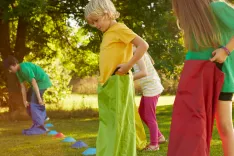Mexican Games for Kids – Fun Traditions Celebrating Culture

Contents
Games sometimes serve not just as entertainment or even development tools, they are also a window into another culture. Mexican games for kids are a vibrant immersion into the world of Mexican traditions, where each activity is infused with the spirit of celebration, family warmth, and joy. These entertainments develop physical skills, social interaction, and creative thinking, helping children better understand the world around them. In this article, we'll examine why traditional Mexican games are so important, study their history, and give practical tips on organizing a Mexican party. You'll also learn about Keiki – a platform with safe and educational games, including those for developing cultural perception.
The Benefits of Playing Traditional Mexican Games
Mexican games for kids improve physical coordination, develop social skills, and strengthen connection with culture. These activities bring enormous benefits for comprehensive child development, affecting such development aspects:
- Physical development. Many games, such as Carreras de Sacos or El Gallito, require active movements, which helps improve coordination, endurance, and motor skills. Children move a lot, increase agility and endurance.
- Social skills. Most Mexican games are team-based, which teaches children to cooperate, negotiate, and respect each other. This strengthens social connections and helps them feel part of a group.
- Cultural education. Traditional Mexican games are an engaging and interactive way to introduce children to traditions, history, and values of Mexican culture without resorting to boring lectures.
- Development of creativity. Many games can be adapted to your conditions, which stimulates imagination and creative thinking. Some tasks literally require unconventional solutions and scenarios, which also excellently affects creative potential.
- Strengthening family bonds. Joint participation is always about unforgettable moments and strengthening relationships between family members and friends.
Classic Mexican Games for Kids (and Their Rules)
There are many traditional games that have become symbols of Mexican celebrations. Below we'll discuss the most popular ones.
Piñata
There's no more popular Mexican entertainment than piñata. How can you remain indifferent to entertainment where you need to wholeheartedly hit something with a stick and get a rain of candy at the end? Piñata rules are quite simple: players with blindfolded eyes take turns trying to break a hanging figure (scarecrow, doll, cardboard dummy) to get sweets. All you need is to make or order a piñata yourself, otherwise you just need bats or sticks and an eye blindfold. You can use musical accompaniment. When music stops, the player hits.
Your task is to explain to children that they need to keep their distance and ensure no one gets into the area where the player swings the bat. Often Pinata game is entertainment for holidays, especially birthdays, as a gift to the birthday child.
La Lotería
You'll be surprised, but many Latino games for kids are built around lottery and everything related to it. The rules are quite simple: players mark images on cards that the host calls out. When someone collects the needed combination or covers all images, they win. For entertainment, you need a deck of cards, cards with images, chips. The game helps develop attention and pattern recognition.
Moreover, each image has its meaning in Mexican culture. This is literally one of the cultural activities for kids that unites generations, as both adults and children can play it.
Carreras de Sacos (Sack Races)
An excellent option from outdoor games for kids. Players hop to the finish line in sacks. You'll need sacks or old pillowcases and free space for such a race. The adults' task is to ensure the track is free of stones, trash, and anything that could interfere or cause falls. The game can be organized as a relay where players pass the sack.
Active and Outdoor Mexican Games
Mexican outdoor games are perfect for parties and active recreation.
El Gallito (Rooster Game – Keep Out Variant)
Players stand in a circle holding hands. One player – the rooster – must break into the circle while others don't let them in. Such entertainment develops agility, reaction speed, and teamwork ability. You can add a second rooster to make the game more complex.
Las Escondidas (Hide and Seek)
One player seeks while others hide. The game develops attentiveness, logic, and ability to move quietly. You can add a home base to the rules where players can save themselves and wait out the seeker.
La Cebollita (Little Onion)
Players hug each other like onion layers. One player tries to tear them apart from each other. This is one of those tasks where you need not only physical strength and agility but also teamwork ability. There's a fine line between desire to achieve the goal and carefulness not to offend or hurt anyone.
El Avioncito (Hopscotch)
You can show Mexican culture for kids through this entertainment because on one hand it's an analogue of hopscotch familiar to many, and on the other hand it's quite an original amusement. Children hop on squares drawn on the ground, throwing stones, developing coordination, balance, and ability to follow rules.
La Cuchara y el Huevo (Spoon and Egg Race)
Players carry an egg in a spoon, trying not to drop it. Naturally, this requires coordination, patience, and attentiveness in the process. The egg itself can be replaced with a potato or any other object.
Calm and Creative Mexican Games
For breaks between active games, there are calm activities that develop creativity.
Making Maracas
An excellent Fiesta games for kids option when it's too hot outside or little ones need rest after active activities. Using plastic bottles or paper cups, rice, beans, glue, paints, you can create your own maracas. Simply pour everything that makes sounds inside bottles and cups, decorate them. The craft develops fine motor skills, creativity, and sense of rhythm.
Origami (Papel Picado)
Traditional Mexican decorations are often made from paper – they're bright, emphasize connection with ancestors and culture, can serve to decorate rooms. But even the process itself is captivating and inspires creative realization. You'll need colored paper and scissors. Explain how to fold paper and cut patterns. There are many schemes, and when you understand the principle – they become unnecessary, experiments begin. DIY Mexican games develop fine motor skills, patience, and attention to detail.
Decorating Sombreros
A bright example of fun Mexican games where you can create something creative while getting a holiday outfit. Prepare sombreros in advance (from cardboard or straw), paints, feathers, beads. Let children express themselves while decorating hats. The activity develops creativity, sense of style, and fine motor skills.
Stringing Necklaces with Dried Beans
Materials for such beads are available at home. You just need to show some creativity, select thread of the right length, plus dried beans or peas. The craft develops fine motor skills, patience, and attention to detail.
Game History: Where Did They Come From?
Many traditional Mexican games have a rich history rooted deep in centuries. Knowledge of their origin adds special meaning to entertainment and allows deeper immersion into culture. For example, contrary to popular belief, piñata is not a purely Mexican invention. It's believed to have originated in China, where it was used to celebrate New Year. Then it reached Europe, and from there was brought by Spanish missionaries to Mexico, where it began being used for religious purposes, and later for parties.
La Lotería has European origins but was adapted and popularized in Mexico in the 18th century. It became a symbol of Mexican culture and family gatherings. Each card in the game has a unique image and name that became part of Mexican folklore.
Sack races were popular in rural areas and often held at fairs and holidays. They were a way to test strength, agility, and endurance. El Palo Encebado has Aztec roots and was part of religious rituals. The pole symbolized ascension to gods. Nowadays it's a fun game of agility and strength.
How to Integrate Mexican Games into Modern Celebrations?
You can integrate tradition into everyday life using Mexican party games for kids. We've selected several tips for you:
- Using games for themed parties. For example, organizing a Fiesta with piñata and La Lotería.
- Prepare tasks for different ages. Simplify rules for toddlers and add competitive elements for teenagers.
- Including music and food. Use mariachi music and serve tacos to create a real Mexican celebration atmosphere.
- Organizing a "mini-Olympics" of Mexican games. Create a tournament with prizes for winners.
- Tell stories and tales. Games for cultural education work well combined with traditional tales and beliefs.
Online Games for Breaks During Active Games
Smartphone or tablet games can be viewed as a variety of calm Mexican activities. They can be directed toward useful purposes, using them as development and education tools. Keiki helps with this, serving as a bridge between a child's curiosity and knowledge they can gain. You can use the app for party breaks, with such educational games for kids:
- Food Names. Mexican cuisine is rich in unusual flavors and dishes – this is an important part of culture. With this word learning game, children will find it easier to expand their vocabulary to later use it including for joint culinary experiments.
- Sweet Words. Who said you can only play with piñata one way? This game uses its principle, and there's no less fun with it. Collect constructions from words and articles to break the piñata and win the round.
- Numbers. In the decorations of a festive candy cart, you can easily learn numbers and simple operations with them using visual examples with candies and cupcakes. Such number learning games show the greatest effectiveness thanks to clear and understandable examples.
Mexican games for kids are not only fun but also beneficial. This is a real foundation for understanding other cultures, customs, and views.
FAQ
The most famous Mexican game is undoubtedly Piñata. It's a symbol of Mexican celebrations and used at birthdays and parties worldwide.
You can teach your children Mexican culture using traditional Mexican games, listening to mariachi music, cooking traditional dishes, and reading books about Mexican history and traditions.
Yes, most of these are exactly Mexican party games for kids. They're fun, interactive, and don't require complex preparation.


